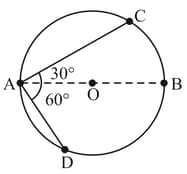Distance and Displacement
Distance and Displacement: Overview
This Topic covers sub-topics such as Average Speed, Average Velocity, Instantaneous Velocity, Instantaneous Speed, Displacement of Body and, Distance as Path Length
Important Questions on Distance and Displacement
A car moves a distance of 200 m. It covers the first half of the distance at speed and the second half of distance at speed v. The average speed is . Find the value of v
A bus travelling the first one third distance at a speed of , the next one third at and the last one – third at . The average speed of the bus is
A particle covers half of its total distance with speed and the rest half distance with speed . Its average speed during the complete journey is
A car covers the first half of the distance between two places at and other half at . The average speed of the car is
A particle shows distance–time curve as given in this figure. The maximum instantaneous velocity of the particle is around the point:
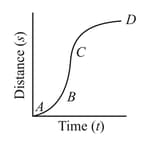
A car moves from X to Y with a uniform speed and returns to X with a uniform speed . The average speed for this round trip is
A particle moves along a straight line such that its displacement at any time t is given by
metres
The velocity when the acceleration is zero is
The displacement of particle moving in one dimension, under the action of a constant force is related to the time by the equation where is in meters and in seconds. Find the displacement of the particle when its velocity is zero.
The displacement of particle moving in one dimension, under the action of a constant force is related to the time by the equation where is in meters and in seconds. Find the displacement of the particle when its velocity is zero.
The coordinates of a moving particles at any time are given by and . The speed of the particle at time is given by –
The coordinates of a moving particles at any time are given by and . The speed of the particle at time is given by –
In , a particle goes from point to point , moving in a semicircle of radius (see figure). The magnitude of the average velocity is
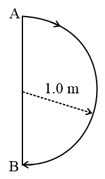
A particle moves in a circle of radius Find its displacement and the distance covered for half the period of its revolution.
A boy moves from A to B through , B to C through and again from C to D through . Find his displacement.
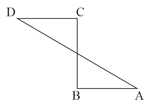
A particle moving along the path , from to . Then the distance travelled by the particle is
A vehicle travels half the distance with speed and the remaining distance with speed . Its average speed is:
The distance travelled by an object in time is given by . The instantaneous speed of the object at will be :
A disc is rolling without slipping on a surface. The radius of the disc is At the top most point on the disc is as shown in figure. When the disc completes half of its rotation, the displacement of point from its initial position is
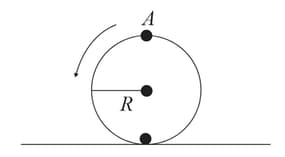
As shown in the figure, a particle is moving with constant speed . Considering its motion from to , the magnitude of the average velocity is:
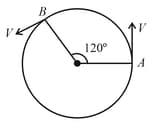
Two particles move from A to C and A to D on a circle of radius R and diameter AB. If the time taken by both particles are the same, then the ratio of magnitudes of their average velocities is
